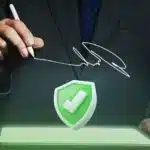
As our lives become increasingly digital, the need to verify the authenticity of electronic documents, such as digital signature verification, has never been more critical. But how to verify a digital signature?
In this article, we will explore the process of verifying a digital signature and answer some common questions regarding its implementation.
Understanding Digital Signature Verification
Digital signature verification involves confirming the signer’s identity and ensuring the signed document’s authenticity. It is a multi-step process that employs cryptographic algorithms to validate the integrity and origin of the signature.
Also Read: What is Digital Signature and Understanding Certified Digital Signature
How does Digital Signature Verification Work?
Digital signature verification is a process that ensures the integrity and authenticity of electronic documents. It employs advanced cryptographic techniques to validate the digital signature against the original document. Here’s how it works:
Identity verification
During the digital signing process, the signer’s identity is verified using their unique digital certificate issued by a trusted certification authority (CA). This certificate includes the signer’s public key and other identifying information. To verify the digital signature, the recipient uses the signer’s public key to decrypt the signature.
Authenticity verification
Once the signature is decrypted, the recipient compares it with the document’s original content. Any changes or alterations made to the document after the signature was applied will result in a mismatch, indicating potential tampering. If the decrypted signature matches the document’s content, it confirms its integrity and authenticity.
How to Verify a Digital Signature
1. Obtain the digital signature
Start by obtaining the digitally signed document or message you wish to verify. This can be in various formats, such as PDF, Word, or others.
2. Open the document
Open the document using compatible software or applications, such as Adobe Acrobat or other digital signature validation tools.
3. Locate the digital signature
Look for the digital signature within the document. In most cases, it is indicated by a specific icon or a visual representation that distinguishes it from the rest of the content.
4. Check the signature details
Select the digital signature within the document and access the signature properties or details. This option is usually available through a right-click or a dedicated menu within the software.
5. Validate the signature
There should be an option to validate or verify the signature in the signature properties or details. Click on this option to initiate the validation process.
6. Verify the certificate
The validation process will involve checking the digital certificate associated with the signature. The software will verify the certificate’s validity, expiration date, and the trusted certification authority (CA) that issued it.
7. Check the document integrity
The software will also verify the document’s integrity by comparing the stored hash value of the document against the recalculated hash value. If the document has not been tampered with, the hash values should match, indicating the document’s integrity.
8. Examine the signature status
Once the validation process is complete, the software will display the signature status. The document is authentic if the signature is valid and the signer’s identity has been verified. On the other hand, an invalid signature may indicate tampering or issues with the certificate.
9. Verify the signer’s identity (optional)
Sometimes, you may want to verify the signer’s identity further. This can be done by cross-referencing the information within the certificate, such as the name or organization, with known and trusted sources.
Does Every Document Need to be Verified?
While verifying digital signatures adds an extra layer of trust and assurance, not every document requires verification.
The need for verification depends on factors such as the sensitivity of the document, the level of trust required, and the legal or regulatory requirements of the specific context.
How Much Does Digital Signature Verification Cost?
Digital signature verification costs vary depending on several factors, including the software or platform used, the volume of signatures to be verified, and any additional services or features required.
Many digital signature solutions offer free verification tools, while others may charge a fee for more advanced features or high-volume verification needs.
Researching and comparing different options is advisable to find a solution that aligns with your requirements and budget.
Conclusion
Verifying digital signatures is vital for ensuring electronic documents’ integrity and authenticity. Following the outlined steps and using compatible software or tools, you can confidently validate digital signatures and trust the electronic documents you encounter.
To simplify the process and enjoy the benefits of seamless digital signature verification, explore the user-friendly features of Mekari Sign.
With Mekari Sign, you can easily ensure your electronic documents’ trustworthiness. Start verifying digital signatures confidently today with Mekari Sign’s trusted digital signature solution.






